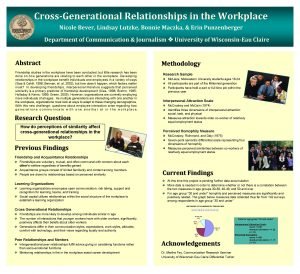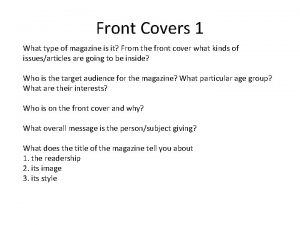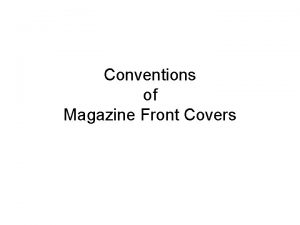Methods Magazine Covers Caitlin Light Ross Smith Jon





















- Slides: 21

Methods & Magazine Covers Caitlin Light, Ross Smith, Jon Bakos, Becky Adams © 2005

Presentation Overview • Some GEP History • A survey of our methods • TIME magazine cover research • Pulp SF magazine cover research

Background Founded in Jan of 1998 by two faculty of the University of Michigan, Ann Arbor Dr. Eric S. Rabkin Dr. Carl P. Simon

Background • We meet weekly in lovely Angell Hall • Undergraduate researchers, working in pairs • Lots of team spirit! Companion GEP units: MSU in East Lansing Texas A&M at College Station University of Trento at Trento, Italy

The GEP Hypothesis Cultural phenomena evolve as do biological organisms, that is, as complex adaptive systems. Complex Adaptive System The whole adapts to the parts, and the parts adapt to the whole.

Studying Cultural Change Through Creative Works …Masterpiece Works • Known for being exceptional • Read by specialists • Indicative of specific views held by a few • Studied by most humanities scholars • • …Popular Works Known for being popular/successful Read by multitudes Indicative of broad views held by many Studied by the GEP! But what popular works?

…Pulp Science Fiction! Why Pulp SF? • • We know a lot about science fiction Begins in ‘ 26 and matures in the 20 th century Magazines provide contextual material Story reprints are a way to track “fitness” Many undergraduates like to read it We have a lot on microfilm at U-M …You have to begin somewhere!

Methods of the GEP What do we need in order to study pulp SF? – Particular traits to study (Fields & Values) – Agreement when identifying traits (ICR) – Comparison of works en masse (Database) – Ability to revise our approach (Dialectics)

Methods of the GEP • Fields & Values – Fields: specific traits that we study. – Values: Specific possibilities of those traits. Primary Colors of Light: Red, Green, Blue Values are coded and stored in the database.

Methods of the GEP • Rigorous Definitions – Agreement on meaning and usage – Also a dialectic process (constantly examined) Genre Content: The element in the story that would make most readers recognize the story as Science Fiction and without which the story might not be generally considered to be science fiction by ordinary readers. Definitions allow us to select the right values.

Methods of the GEP • Inter-Coder Reliability (ICR) – Agreement between researchers on codings – The keystone of our credibility – Many of our methods serve to increase ICR It’s really important!

Methods of the GEP • Dialectic Database Design – A relational computer database – The dialectic method + Thesis = Antithesis Synthesis

Methods of the GEP …That’s it for methods! Time for the good stuff… Magazine Covers!

Magazine Covers A New Frontier for the GEP: Magazine Covers (GEPMC) TIME Covers Project

TIME Covers Project • Goals – Uncover the patterns / topics of public interest – Give a context for GEP findings in other areas • Why TIME? – Began in 1923 and reputable – Reports on a broad field of news interest – Weekly issues = “high resolution” data

TIME Covers Project • What do we examine? – Cover articles • What are the Fields & Values? – Date. The issue’s week of publication. – Topics. 20+ different categories for articles (“Int’l Politics, ” “Information Technology”, etc. ) – Topics have: • Presence. How important the topic is in the issue. • Value. How positive or negative the topic appears.

Date? December 15 th, 1941 Topic? International Politics Value? Positive Presence? High

Date? May 1 st, 1972 Topic? International Politics Value? Neutral Presence? High

Date? January 14 th, 2002 Topic? Information Technology International Politics Value? Positive Neutral/ Negative Presence? High Low

TIME Covers Project • Status – After three years, complete! – ICR: Very high • Results – …are mostly top secret! – Romanticizing World War II – The rise of digital technology

GEPMC • What do we examine? – Cover articles • What are the Fields & Values? – Date. The issue’s week of publication. – Topics. 20+ different categories for articles (“Int’l Politics, ” “Information Technology”, etc. ) – Topics have: • Presence. How important the topic is in the issue. Value. How positive or negative the topic appears.
 Bandura sample size
Bandura sample size Magazine front cover ideas
Magazine front cover ideas Companion diagnostic
Companion diagnostic Objectives of magazine
Objectives of magazine Front covers of magazines
Front covers of magazines Music magazine front covers
Music magazine front covers Skate magazine covers
Skate magazine covers 1920s magazine cover
1920s magazine cover Strapline magazine
Strapline magazine Methods for salvage covers
Methods for salvage covers Light light light chapter 23
Light light light chapter 23 Into the light chapter 22
Into the light chapter 22 Light light light chapter 22
Light light light chapter 22 Two lives changed
Two lives changed Caitlin driscoll
Caitlin driscoll Bronwyn and caitlin
Bronwyn and caitlin Caitlin meehan
Caitlin meehan Caitlin d. davidson
Caitlin d. davidson Caitlin coyle
Caitlin coyle Ciasta mondrian caitlin freeman
Ciasta mondrian caitlin freeman Caitlin bevers workshop
Caitlin bevers workshop Ataf ligament
Ataf ligament




































